Being battered 6-0 at the Etihad was one of the worst days of the season for Spurs fans. But has the mauling at the hands of Manuel Pellegrini’s team inspired the current system of Tim Sherwood?
Although the players are different, there are some distinct similarities between how both sides are currently setting up to play. Something that goes much deeper than both using a twin striker approach and it starts at the back.
Centre backs
Both sides have struggled with injury, but Manuel Pellegrini has been pairing a centre back that can bring the ball forward in Vincent Kompany, with one who sits deeper in Matija Nastasic.
This is by design to take advantage of teams that are playing with one striker in a 4-2-3-1 to move the ball quickly in to midfield. It also gives the element of surprise as a centre back moves in to areas he is not expected to be, whilst getting an extra body in to the midfield zone.
This is something Kompany has been doing regularly since his return from injury and was extremely prevalent against Arsenal.
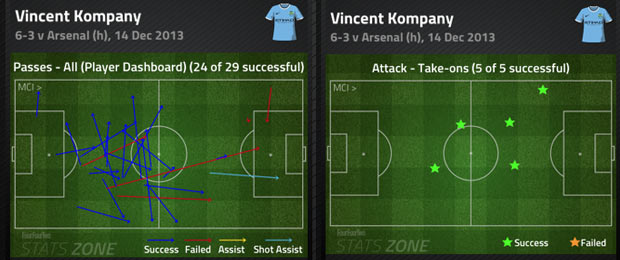
Tim Sherwood has also been hamstrung by injuries, but is too pairing a player who can drive forward with the ball and a holding centre back. Michael Dawson has been the ideal sitting player, whilst Vlad Chiriches was brought by AVB to bring a dynamic cut and thrust to the position.
As looked at when he arrived in “How Vlad Chiriches will change the Spurs back line,” the Romanian is excellent at bringing the ball out. He is comfortable with it at his feet and often bursts forward like an old school Libero, as he can move up the park and instigate attacks from deep.
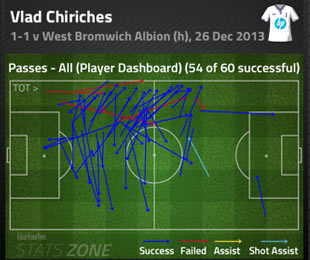
Full Backs
The full back positions vary in their duties between the left back and right back due to the player in front of them.
The left back has a playmaking midfielder ahead of him who drifts inside. So, naturally the full back is tasked with getting further forward to support the attack.
Manuel Pellegrini has used Aleksander Kolorov and Gael Clichy in this role as they have good engines to get up and down the line.
Kolorov got the nod in Man City’s last Premier League match at Swansea and we can see how high he receives the ball in the final third. We can also see how the ball is moved directly to him, often over some distance, by the length of some of the passing lines. The passes are also diagonal in nature as the ball comes out to him rather than up the line.
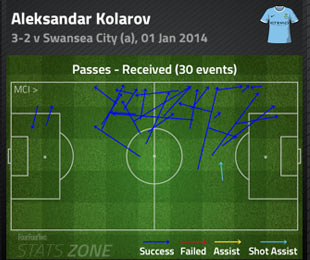
So far, Tim Sherwood has used Danny Rose and Ezekiel Fryers in the left back role. Also with an inside drifting playmaker ahead of them in Christian Eriksen, they too have been tasked with getting forward to provide width and support the attack.
Rose got the nod at West Brom and he, like Kolorov, receives the ball high up in the final third, often with it travelling over great distance to get to him. The passes are also diagonal in to him from central areas and rarely up the line.
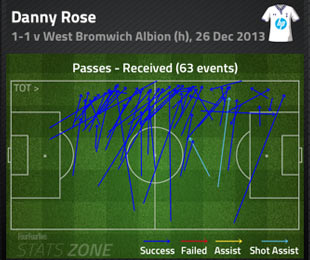
The right full back has a winger in front of him, so he is more of a support player to the wide man and only occasionally moves past on the under or overlap.
In comparison to the left full back, the right back gets up in to the final third less due to the man in front of him staying wide. When he is here, he receives flatter passes. This is because he goes beyond his winger or takes possession from passes played back up the line from the wide man returning the ball to him.
Pablo Zabaleta has been Manuel Pellegrini’s man of choice here and we can see how he receives the ball out to him from the centre up until the final third. When he gets to here, Zabaleta combines with Jesus Navas and the passes flatten out up the line between the pair.
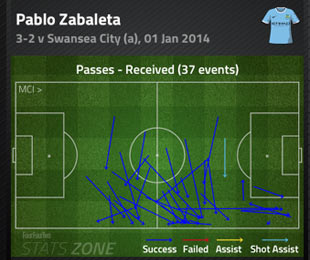
Tim Sherwood has gone for Kyle Walker, but the role has seen him play in a similar tandem with Aaron Lennon.
Walker too receives the ball directly out to him from the centre of the pitch up until the final third. Just like Zabaleta in Pellegrini’s system, Walker doesn’t get up in to the final third as much as his opposite full back. When he does, the passes also flatten out and go up the line as he links with his winger.
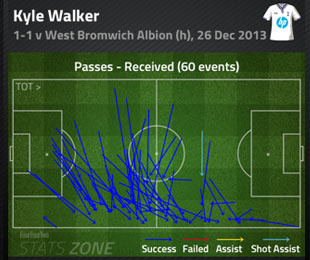
Midfielders
Combining with their full backs, the wide players in both Pellegrini’s and Sherwood’s systems function in a similar manner.
The left-sided midfielder is a playmaker, who has licence to drift in to the middle in order to get additional numbers in here, looking to play through balls.
David Silva has been Manuel Pellegrini’s choice, but he also has played Samir Nasri here during the Spaniard’s injury absence.
Silva does start on the left, but in the final third, has almost a free role to roam wherever the play takes him.
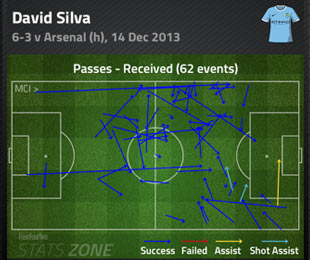
Tim Sherwood has been using Christian Eriksen in a very similar mould as he tries to get on the ball in advanced areas. He, like Silva, is not a natural wide man, but a playmaker that likes to be in the centre, where he is also given the freedom to roam across the formation.
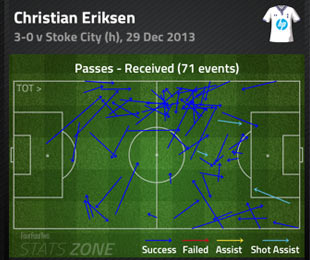
Over on the right, Pellegrini has often used Jesus Navas as an out and out winger. We saw above how he combines with Zabaleta. His role to beat his man and get the ball in the box, just as he did in City’s last Premier League match with Swansea.
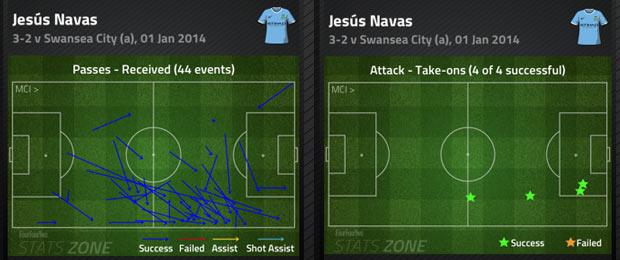
Aaron Lennon has performed a similar role for Tim Sherwood in the new coach’s system. Lennon has formed a nice one-two punch with Kyle Walker, which also sees him tasked with beating his opponent to get crosses in.
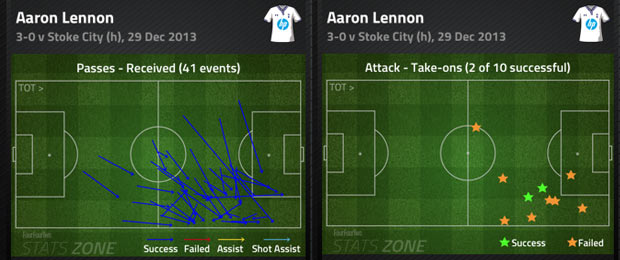
The centre of midfield is where the quality of personnel really come in to effect. Here, Man City are a step ahead due to their combination of Yaya Toure and Fernandinho. The Premier League hasn’t seen a pairing in a midfield four with such size, physicality and skill on the ball for a long while.
Both players are able to drop in for one another as the other goes forward. Usually Fernandinho holds and Toure goes in support of the attack, but the Brazilian is also capable of getting up the pitch as he showed when scoring twice against Arsenal.
Both get through an immense amount of work as Fernandinho spreads the play and Toure goes on marauding runs with the ball.
Tim Sherwood has also often tried to get two physical players in to this zone. He has gone with Moussa Dembele and either Paulinho, Nabil Bentaleb or Etienne Capoue.
Dembele performs a similar function to Fernandinho in that he is excellent at distributing the ball left and right in order to shift it to the wide players. He is also able to move it forward through his dribble-drives, which is a trait shared by Yaya Toure.
The problem for Tim Sherwood in this zone is that he would probably like to use Paulinho as the player who drives forward, but hasn’t been able to. The Brazilian’s injury against Stoke has so far put paid to that, but his partnership with Dembele in that match was extremely promising.
Strikers
Up top, Tim Sherwood, like Manuel Pellegrini, opts for two strikers.
Just like the Man City coach, Sherwood likes one of his front men to drop in and try and help his midfield out. The other is tasked with looking to get in-behind the defence, as he stretches the opposition back four. When the ball goes wide, both need to get in the penalty area.
The difference here is again in the personnel that Manuel Pellegrini has available to him.
Sergio Aguero is an excellent player at coming short and then running in-behind. He combines well with Alvaro Negredo. The Spaniard can play as the target man, but is also a good passer and often comes deeper than Aguero to receive the ball.
More recently, without Aguero, Edin Dzeko has come in and the two offer a rotating point of attack. Either of them comes short to receive the ball in the build up. Whoever doesn’t drop in, then looks to stretch the defence higher up in the second phase as they look for through balls.
Here, Tim Sherwood has set us up similarly, but our front duo have defined roles. Emmanuel Adebayor comes short and Roberto Soldado looks to spin in-behind.
We don’t possess a player as dynamic as Aguero, but we do have two strikers that are very good at what they do and can get in the box once the ball has gone wide.
Adebayor is excellent at linking the play and highly capable of picking out a pass. Once the ball has been moved to the flank, he can get in the box and finish. So far, three of his four goals have come from crosses.
Roberto Soldado hasn’t quite yet hit his stride in England. The Spaniard thrives on early crosses and through balls, as looked at in “How Roberto Soldado will change Spurs.” Since the switch to the new system under Tim Sherwood, he is starting to get that service and he does look to be finally finding his feet.
Has Tim Sherwood been inspired by Manuel Pellegrini?
Quite possibly. There are some real crossovers between the twin striker system set up by the Chilean at Man City and that which we are seeing from Spurs since Tim Sherwood took over.
Take the average positions of Man City’s last Premier League match with Swansea.
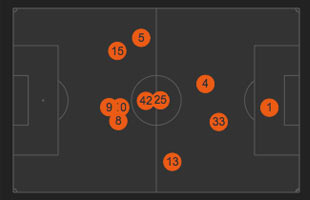
Compare that with ours against Arsenal at the weekend.
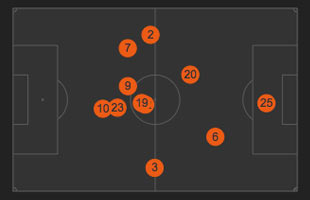
The key crossover areas are at centre back, in the full back areas and in the wide midfield positions, where the two sides function in extremely similar ways.
The main difference is in central midfield, where Tim Sherwood hasn’t had power players such as Sandro and Paulinho to choose from. It’s also unclear whether he wants two box-to-box players, such as Dembele and Paulinho. Or, if he wants one player to sit and one to go, such as Sandro or Capoue alongside Dembele or Paulinho, as he hasn’t had the players available due to injury.
The evolution of Tim Sherwood’s Spurs continues, just how much and if Manuel Pellegrini has inspired his system remains to be seen.
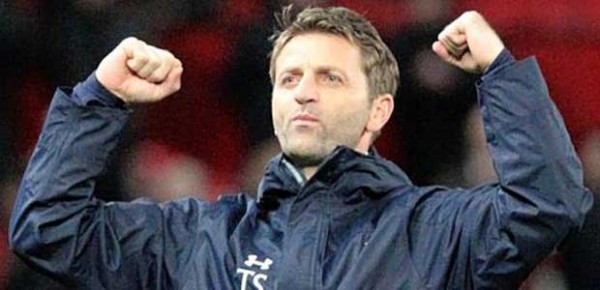
Very well written and resourced article. There are not many I can agree with in Spurs forums but this is good.
Thanks Jack, that’s much appreciated.
Absolutely agree with the article and I firmly believe that will work out for Tim and Tottenham once all players are fit. He knows it and I know it. It’s that simple like 2 n 2. I’ve been surprised how many negative people are saying that 4-4-2 is old and not practical any more. They seems to forget that we finished twice in top 4 playing it and we have won 3 out 4 league games since Tim is in change. Be positive and believe in Tim
The formation can be practical if you have the right personnel. Man City does and overpowers teams with it, but they have had trouble away from home, where just like us, opponents have exploited the space between their defence and midfield. 4-4-2 can have a place, but the other issue for us is that we’ve brought players eg wide forwards Chadli and Lamela who are more suited to 4-3-3.
Great read, good to see some backing for Tim after media and plastic fans getting on his back and calling him a dinosaur for playing 442, just need the players back now COYS
I’m such a huge fan of Manuel Pellegrini- soo wanted him to manage Spurs after we turfed Harry, and if Sherwood wants to imitate him, I’m all for it.
4222 would suit Spurs down to a T, but it requires no fixed wings, with players filling the wing positions at will.
Would love to see a line-up like this; (4-2-2-2)
Lloris; Walker, Chiriches or Kaboul, Vertonghen, Rose or BAE; Sandro/Capoue, Dembele/Bentaleb/Holtby for the defensive centre midfield slots; Chadli/Sigurdsson/Lamela/Lennon/Townsend for the two attacking midfield non-fixed wings slots; Adebayor/Soldado/Kane for the two striker slots.
As with Pellegrini’s teams, 4-2-3-1 would be plan B when we’d either play a possession intensive team or away from home at a tricky venue.
4-2-2-2 certainly would be exciting. Requires intelligent players who are well practised in the system, knowing how and when to fill roles.